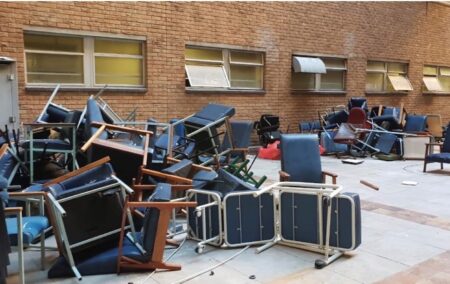The bizarre case of the three doctors and the two broken chairs – and the unanswered questions about failings in South Africa’s public health system.
There’s always been a concern that the public sector doesn’t discipline staff in terms of well-worn industrial relations policies, either timeously, properly or at all. Legislation setting out guidelines for disciplinary procedures has been on the statute book for decades.
The hospital sector has been as poor as any other state sector in carrying out discipline, and the potential consequences of poor or no discipline undermine every attempt to manage institutions that need to be strictly managed.
And then there was the incident of such bizarreness, involving the overzealous ‘disciplining’ of three doctors who had committed no offences. The facts are taken from an article by William Saunderson-Meyer (WSM) published on Politicsweb. That article is paraphrased here.
Saunderson-Meyer describes the ludicrousness of the incident in the following terms: ‘It’s certainly a keeper for my loose-leaf folder, to be filed under any of South Africa’s worst public service failings — workplace pettiness and spite, bullying and envy; organisational dysfunction; gutless management; bureaucratic arrogance, and legal over-reach.’
Three young doctors at Tygerberg Hospital, who were in the process of specialising at Tygerberg in anaesthetics, scavenged two weathered chairs from the hospital’s outdoor dump of written-off and/or broken furniture. Their motivation was to repair them for use in the doctors’ tearoom.
The three had verbal permission and they had checked the chairs through security, and in full view of hospital CCTV. Notwithstanding this, the three were charged with theft. The disciplinary process came about through pressure from officials (unknown) of a trade union (unknown) on management to deal with the doctors ‘with the same alacrity that it dealt with the criminal transgressions of administrative and service employees’.
One Shameem Modack-Robertson presided over the hearing, which she apparently does regularly for the Department of Health. As Saunderson-Meyer says, she was either unusually incompetent or dancing to a political tune. Modack-Robertson has a paramedic diploma and some credits towards a Unisa undergraduate degree, and as Saunderson-Meyer wrote, ‘tarnished the reputations and upended the lives of three doctors who each had undergone more than a decade of rigorous training at one of the finest medical faculties in the world’. Hearings must always be chaired by people of a higher status than the employees who have been charged.
However, despite an array of witnesses, from security guards to departmental heads, who testified to the veracity of the doctors’ version, Modack-Robertson found them guilty.
One doctor was summarily dismissed and the other two were sanctioned to periods of a month’s and a fortnight’s unpaid leave respectively, and given written final warnings.
According to the SA Society of Anaesthesiology, the first doctor would not be able to complete his training and the public service careers of two senior registrar anaesthetists had been sullied.
When the public heard of this, social media was outraged, prompted a petition which, within days, attracted 16 000 signatures, local and international, demanding the doctors’ immediate reinstatement. Very shortly after, the Health Department backed down.
The verdicts were reversed with immediate effect – reduced to written warnings that would be expunged from their records in six months provided the doctors ‘didn’t indulge in any further impromptu interior decorating’.
Who authorised this kangaroo court? Where was the hospital administrator and the Democratic Alliance MEC for Health Dr Nomafrench Mbombo in all this? Why weren’t the findings withdrawn completely? Why was it necessary to find a ‘compromise’ if they were not guilty of an offence? Was this appeasement to the trade union? Was the removal of the chairs against hospital rules, and, if it was, why were the doctors not just told that they weren’t allowed to take the chairs?
Attorney Michael Bagraim, who acted on behalf of two of the doctors, said the overwhelming support they received ‘undeniably’ drove the department’s internal review.
The department has refused to name which trade union was responsible for instigating this debacle. Hazarding a guess, it was the National Education and Health Allied Workers Union (Nehawu). The reason? Nehawu is the most active union in the hospital and Nehawu is to health what the SA Democratic Teachers Union is to education.
We expect more, much more, from the DA. The looming NHI is bad enough; we don’t need this sort of medical ‘keystone cops’ to push young doctors to emigrate as well.
Sara Gon is the head of strategic engagement at the IRR.
If you like what you have just read, become a Friend of the IRR if you aren’t already one by SMSing your name to 32823 or clicking here. Each SMS costs R1.’ Terms & Conditions Apply.

